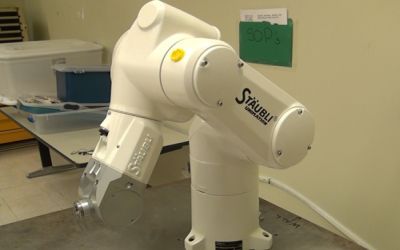GE to Develop Hospital Robot System to Sort and Sterilize Surgical Tools
The Institute of Medicine estimates that tens of thousands of Americans die needlessly every year from avoidable medical errors, including infections acquired during surgery. GE and the U.S. Department of Veterans Affairs have now teamed up to change that. They will develop an intelligent system using robots, computer vision and automatic identification technologies like RFID tags to fetch, sort, and sterilize surgical tools. The system could save lives, and money.


GE and the VA have partnered to develop a robotic system to fetch, sort, and sterilize scalpels and other surgical tools.
The Institute of Medicine estimates that tens of thousands of Americans die needlessly every year from avoidable medical errors, including infections acquired during surgery. GE and the U.S. Department of Veterans Affairs have now teamed up to change that. They will develop an intelligent system using robots, computer vision and automatic identification technologies like RFID tags to fetch, sort, and sterilize surgical tools. The system could save lives, and money.
Â
Some of the technologies behind the system have been helping to automate manufacturing lines for years. But their application in the surgery environment is new. We believe that in combination with a new level of intelligence, they can help make operating rooms run more efficiently, lead to better patient outcomes, and save millions of dollars in healthcare costs, says Lynn DeRose, a principal investigator and auto-ID expert in the Distributed Intelligent Systems Lab at GE Global Research.
DeRose says that scalpels, clamps and other tools will bear unique IDs that the intelligent robotic system can recognize. The system will be designed to perform a series of tasks, including the sorting of surgical tools, sterilization, and location tracking during transportation to and from the operating room. The goal: deliver the right sterilized tools in the right place, at the right time, and in the right order. DeRose says that perhaps her biggest challenge will be to make the robotic system intelligent enough to manipulate a diverse set of surgical implements. Even maneuvering something as simple as a pair of scissors requires lengthy coded instructions for a robot, she says.
Â
A system like this is long overdue. Staff in many hospitals still inspect, wash and count tools by hand, a technique that is inefficient and potentially fraught with errors that can lead to delays and patient harm. An automated robotic system could cut surgical infections, streamline surgery scheduling, and improve efficiency.
According to experts in the field, the surgical operation and recovery setting is considered the fastest growing and most resource intensive section of the hospital, accounting for approximately 30 to 50 percent of a hospitals budget, DeRose says. Simply put, the operating theater is the single largest contributor to a facilitys bottom line.
Â
The designers will evaluate the the two-year, $2.5 million project a VA hospital. To watch a video about the project, CLICK HERE.
Source: GE
The Sterile Processing Conference Survival Guide: How to Make the Most of Your Next Event
March 25th 2025From expert speakers to cutting-edge tools, sterile processing conferences, like the 2025 HSPA Annual Conference and the SoCal SPA's Spring Conference, offer unmatched opportunities to grow your skills, expand your network, and strengthen your department's infection prevention game.
Redefining Material Compatibility in Sterilization: Insights From AAMI TIR17:2024
March 24th 2025AAMI TIR17:2024 provides updated, evidence-based guidance on material compatibility with sterilization modalities. It offers essential insights for medical device design and ensures safety without compromising functionality.